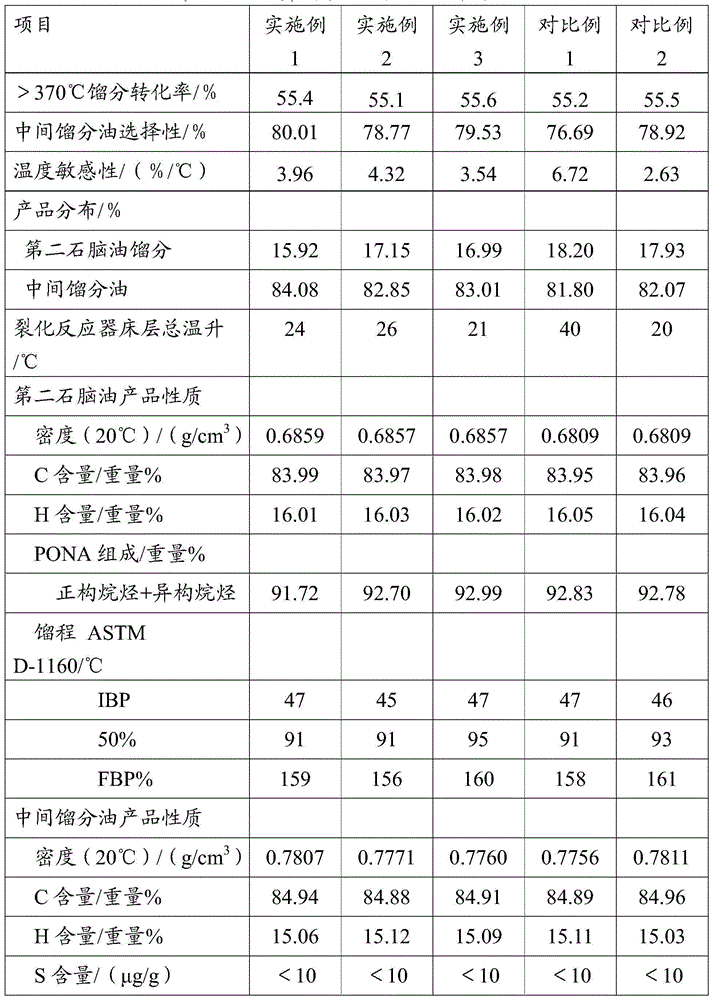Method for producing middle distillate oil through hydrogenation of Fischer-Tropsch synthesis oil
A technology for Fischer-Tropsch synthetic oil and middle distillate oil, which is used in hydrotreating process, petroleum industry, treatment of hydrocarbon oil, etc., can solve the problems of low yield and low selectivity of middle distillate oil, etc. Yield, reducing bed temperature rise, reducing the effect of secondary cracking
- Summary
- Abstract
- Description
- Claims
- Application Information
AI Technical Summary
Problems solved by technology
Method used
Image
Examples
Embodiment 1
[0038] The whole fraction of Fischer-Tropsch synthetic oil enters the hydrorefining reactor, and reacts with the hydrorefining catalyst RTF-1. After the effluent of the hydrorefining reaction is separated and fractionated, the first naphtha fraction, light diesel fraction and heavy oil fraction are obtained . The distillate oil A is added to the heavy oil fraction, and the mass fraction of the distillate oil A is 3% based on the heavy oil fraction. The heavy oil fraction after adding distillate oil A enters the hydroisomerization cracking reactor, and contacts with the hydroisomerization catalyst to perform the hydroisomerization cracking reaction. The effluent from the hydroisomerization cracking reactor is separated and fractionated to obtain the second The naphtha fraction, middle distillate and tail oil fraction, and the tail oil fraction are recycled to the inlet of the hydroisomerization cracking reactor for further reaction. See Table 3 and Table 4 for specific reaction...
Embodiment 2
[0041] The whole fraction of Fischer-Tropsch synthetic oil enters the hydrorefining reactor, and reacts with the hydrorefining catalyst RTF-1. After the effluent of the hydrorefining reaction is separated and fractionated, the first naphtha fraction, light diesel fraction and heavy oil fraction are obtained . The distillate B is added to the heavy oil fraction, and the mass fraction of the distillate B is 1% based on the heavy oil fraction. The heavy oil fraction after adding distillate oil B enters the hydroisomerization cracking reactor, and contacts with the hydroisomerization catalyst to carry out the hydroisomerization cracking reaction. The effluent from the hydroisomerization cracking reactor is separated and fractionated to obtain the second The naphtha fraction, middle distillate and tail oil fraction, and the tail oil fraction are recycled to the inlet of the hydroisomerization cracking reactor for further reaction. See Table 3 and Table 4 for specific reaction condi...
Embodiment 3
[0044] The whole fraction of Fischer-Tropsch synthetic oil enters the hydrorefining reactor, and reacts with the hydrorefining catalyst RTF-1. After the effluent of the hydrorefining reaction is separated and fractionated, the first naphtha fraction, light diesel fraction and heavy oil fraction are obtained . The distillate C is added to the heavy oil fraction, and the mass fraction of the distillate C is 5% based on the heavy oil fraction. The heavy oil fraction after adding distillate oil C enters the hydroisomerization cracking reactor, and contacts with the hydroisomerization catalyst to carry out the hydroisomerization cracking reaction. The effluent from the hydroisomerization cracking reactor is separated and fractionated to obtain the second The naphtha fraction, middle distillate and tail oil fraction, and the tail oil fraction are recycled to the inlet of the hydroisomerization cracking reactor for further reaction. See Table 3 and Table 4 for specific reaction condi...
PUM
| Property | Measurement | Unit |
|---|---|---|
| diameter | aaaaa | aaaaa |
Abstract
Description
Claims
Application Information
 Login to View More
Login to View More - R&D
- Intellectual Property
- Life Sciences
- Materials
- Tech Scout
- Unparalleled Data Quality
- Higher Quality Content
- 60% Fewer Hallucinations
Browse by: Latest US Patents, China's latest patents, Technical Efficacy Thesaurus, Application Domain, Technology Topic, Popular Technical Reports.
© 2025 PatSnap. All rights reserved.Legal|Privacy policy|Modern Slavery Act Transparency Statement|Sitemap|About US| Contact US: help@patsnap.com



